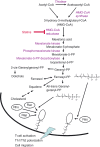Regulation of different inflammatory diseases by impacting the mevalonate pathway
- PMID: 19191903
- PMCID: PMC2678178
- DOI: 10.1111/j.1365-2567.2008.03011.x
Regulation of different inflammatory diseases by impacting the mevalonate pathway
Abstract
The 3-hydroxy-3-methyl-glutaryl-coenzyme A reductase inhibitors (statins) interfere with the mevalonate pathway. While initially developed for their lipid-lowering properties, statins have been extensively investigated with respect to their impact on autoantigen and alloantigen driven immune responses. Mechanistically it was shown that statins modify immune responses on several levels, including effects on dendritic cells, endothelial cells, macrophages, B cells and T cells. Several lines of evidence suggest that statins act in a disease-specific manner and are not effective in each immune disorder. This review discusses possible modes of action of statins in modulating immunity towards autoantigens and alloantigens.
Figures

Similar articles
-
Immune modulatory effects of statins.Immunology. 2018 May;154(1):69-75. doi: 10.1111/imm.12902. Epub 2018 Feb 20. Immunology. 2018. PMID: 29392731 Free PMC article. Review.
-
The beneficial effects of statins in autoimmune disease therapy.Drug News Perspect. 2007 Apr;20(3):165-9. doi: 10.1358/dnp.2007.20.3.1092097. Drug News Perspect. 2007. PMID: 17520093 Review.
-
Statins: pros and cons.Med Clin (Barc). 2018 May 23;150(10):398-402. doi: 10.1016/j.medcli.2017.11.030. Epub 2017 Dec 29. Med Clin (Barc). 2018. PMID: 29292104 Free PMC article. Review.
-
Statins and autoimmune diseases.Autoimmun Rev. 2005 Mar;4(3):123-9. doi: 10.1016/j.autrev.2004.08.037. Autoimmun Rev. 2005. PMID: 15823497 Review.
-
Mevalonate signaling, COPD and cancer: the statins and beyond.J Investig Med. 2019 Apr;67(4):711-714. doi: 10.1136/jim-2018-000829. Epub 2019 Feb 20. J Investig Med. 2019. PMID: 30787037 Review.
Cited by
-
Promising drug repurposing approach targeted for cytokine storm implicated in SARS-CoV-2 complications.Immunopharmacol Immunotoxicol. 2021 Aug;43(4):395-409. doi: 10.1080/08923973.2021.1931302. Epub 2021 May 31. Immunopharmacol Immunotoxicol. 2021. PMID: 34057871 Free PMC article. Review.
-
Upstream Statin Therapy and Long-Term Recurrence of Atrial Fibrillation after Cardioversion: A Propensity-Matched Analysis.J Clin Med. 2021 Feb 17;10(4):807. doi: 10.3390/jcm10040807. J Clin Med. 2021. PMID: 33671264 Free PMC article.
-
Lovastatin promotes the self-renewal of murine and primate spermatogonial stem cells.Stem Cell Reports. 2023 Apr 11;18(4):969-984. doi: 10.1016/j.stemcr.2023.02.011. Stem Cell Reports. 2023. PMID: 37044069 Free PMC article.
-
Impact of recipient statin treatment on graft-versus-host disease after allogeneic hematopoietic cell transplantation.Biol Blood Marrow Transplant. 2010 Oct;16(10):1463-6. doi: 10.1016/j.bbmt.2010.05.006. Epub 2010 May 26. Biol Blood Marrow Transplant. 2010. PMID: 20685260 Free PMC article.
-
The interplay between regulatory T cells and metabolism in immune regulation.Oncoimmunology. 2013 Nov 1;2(11):e26586. doi: 10.4161/onci.26586. Epub 2013 Oct 21. Oncoimmunology. 2013. PMID: 24404429 Free PMC article. Review.
References
-
- Maron DJ, Fazio S, Linton MF. Current perspectives on statins. Circulation. 2000;101:207–13. - PubMed
-
- Youssef S, Stuve O, Patarroyo JC, et al. The HMG-CoA reductase inhibitor, atorvastatin, promotes a Th2 bias and reverses paralysis in central nervous system autoimmune disease. Nature. 2002;420:78–84. - PubMed
-
- Zipp F, Waiczies S, Aktas O, et al. Impact of HMG-CoA reductase inhibition on brain pathology. Trends Pharmacol Sci. 2007;28:342–9. - PubMed
Publication types
MeSH terms
Substances
Grants and funding
LinkOut - more resources
Full Text Sources
Medical

